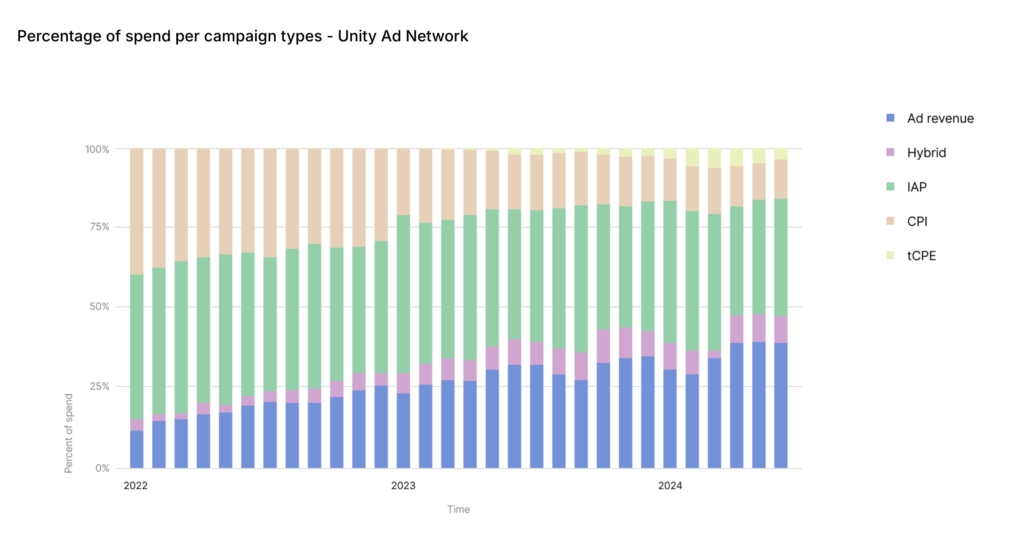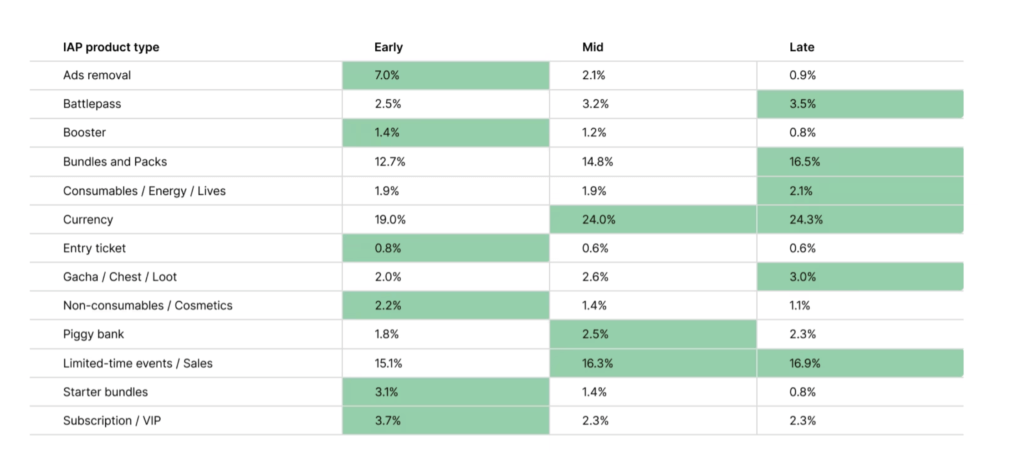Key Trends in Mobile Game Monetization and User Acquisition: Insights from Unity’s 2024 Report
How are mobile user acquisition strategies evolving for mobile games? Why are in-game ads gaining popularity? How has the importance of offerwalls increased? What percentage of users make in-game purchases? Why are A/B tests crucial for optimizing monetization in mobile games? You can read all about these topics in the summary of Unity’s latest report: 2024 Mobile Growth and Monetization Report.
Diversification of User Acquisition Strategies
The mobile gaming market is becoming increasingly competitive, forcing developers to seek more sophisticated methods for user acquisition. Unity’s report highlights a significant trend away from traditional campaigns solely based on cost per install (CPI).

Source: https://unity.com/resources/mobile-growth-monetization-report-2024
The new popular strategies include:
- Return on Ad Spend (ROAS) campaigns: These allow for the optimization of ad spending based on the actual revenue generated by acquired users.
- Event-based campaigns: These focus on acquiring users who are more likely to perform desired actions in the game, such as completing a specific level or making a first purchase.
Interestingly, mobile game developers often combine different types of campaigns to create complex user acquisition strategies. For example, they might use CPI campaigns to increase the number of installs, then switch to ROAS or event-based campaigns for more valuable users.
The report also highlights the growing role of artificial intelligence and machine learning in optimizing these campaigns, allowing for more precise targeting and better utilization of ad budgets.
The Growing Importance of In-Game Ads
A global increase in ad engagement by 3.2% might seem small, but on a market-wide scale, it’s a significant growth. Unity’s report points to several key factors driving this trend:
- Improvement in ad quality: Developers and advertisers are focusing on creating ads that are more interactive and better integrated with gameplay.
- Increasing popularity of rewarded video ads::
- In word games: 38.4% of players
- In RPG games: 37.6% of players
- In casual games: 36% of players
- These high engagement rates show that players are willing to watch ads in exchange for in-game benefits.
- Contextual ad placement: The report suggests that showing ads at the right moments in the game (e.g., between levels or when the player runs out of resources) can increase engagement by up to 38.1%
- Variety of ad formats: In addition to video ads, the report discusses the effectiveness of other formats like playable ads (interactive ads where players can test out gameplay) and offerwalls.
Unity emphasizes that the key to success is balancing monetization through ads with the user experience. Games offering 15-20 different rewarded ad placements can achieve engagement rates as high as 46%.
Offerwall as an Effective Tool for User Acquisition and Retention
Offerwall, a special section in the game offering rewards for completing specific tasks (often in other apps), proves to be an extremely effective tool. Unity’s report presents impressive statistics:
- Users acquired through offerwalls have a 100% higher lifetime value (LTV) on day 7 after installation compared to users acquired through other ad formats.
- On day 30 after installation, the LTV of these users remains 52.1% higher.
- The retention rate of users acquired through offerwalls is 45.8% higher on day 1, 86.1% higher on day 7, and 71.7% higher on day 14 compared to other acquisition channels.
The report highlights several factors behind the success of offerwalls:
- High-quality users: People using offerwalls are generally more engaged and more likely to interact with the game.
- Engagement effect: Completing tasks in an offerwall builds a sense of investment in the game, leading to long-term engagement.
- Exposure to premium content: Offerwalls often provide access to premium content, which can encourage users to make purchases later on.
Unity recommends that developers integrate offerwalls as a key element of their monetization and user retention strategies.
Microtransactions Still Crucial for Revenue
Although only a small percentage of players make in-game purchases, their impact on revenue is significant. Unity’s report presents fascinating data:
- Only 1.83% of users make in-game purchases.
- However, 28.81% of those who make a purchase do so again.
- Moreover, 26.47% of additional purchases occur within the first 30 days after the initial purchase.

Best-Selling In-App Purchases in Games
These statistics emphasize the crucial importance of:
- The first microtransaction: Convincing a user to make their first purchase is critical.
- Early engagement: The first 30 days are a key period for building the habit of making purchases.
- User segmentation: Identifying and targeting potential paying users can significantly boost revenue.
The report also suggests that developers should focus on:
- Optimizing first-purchase offers
- Creating attractive bundles and promotions during the first month after installation
- Personalizing offers based on user behavior
Unity emphasizes that despite the growing role of ads, microtransactions remain the foundation of monetization for many mobile games.
The Effectiveness of A/B Testing in Monetization Optimization
A/B testing has proven to be a key tool in the arsenal of mobile game developers. Unity’s report provides detailed data on the most popular areas of testing:
- Bidding systems (77.1% of developers):
- Testing different bidding algorithms
- Optimizing pricing strategies
- Experimenting with different auction models
- Adding or removing specific ad networks (51.9%):
- Evaluating the performance of various ad networks
- Testing new, emerging platforms
- Optimizing the ad network mix to maximize revenue
- Optimizing pricing for individual countries (41.2%):
- Adjusting prices to local purchasing power
- Testing different pricing strategies in different markets
- Tailoring offers to cultural specifics
Additionally, the report points to the growing popularity of A/B testing in areas such as:
- Designing the in-game store user interface
- Optimizing ad display timing
- Testing different reward mechanisms for watching ads
Unity emphasizes that effectively utilizing A/B tests requires:
- Clearly defined goals and success metrics
- A sufficiently large test sample
- Continuous iteration and improvement based on results
The report concludes that companies consistently utilizing A/B testing can significantly increase their revenue and improve user retention over the long term.
In summary, Unity’s 2024 Mobile Growth and Monetization Report offers deep insights into the changing landscape of mobile game monetization, highlighting the importance of diversifying mobile user acquisition strategies, continuous optimization, and a deep understanding of user behavior. Developers who can effectively leverage these trends will have the greatest chance of success in the competitive world of mobile gaming.
SKAdNetwork: How Apple deals the cards in the Poker Game of iOS User Acquisition?
How are mobile user acquisition strategies evolving for mobile games? Why are in-game...

